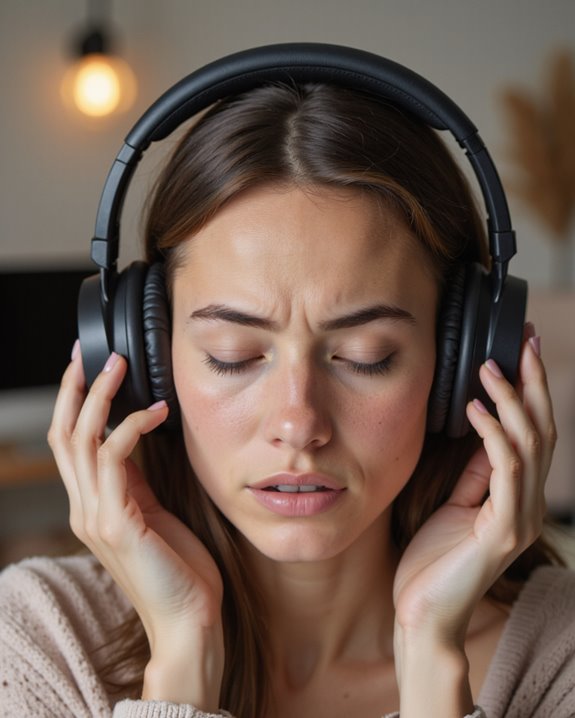As an Amazon Associate, we earn from qualifying purchases. Some links may be affiliate links at no extra cost to you. Although our opinions are based on curated research, we haven't used these products. Articles generated with AI.
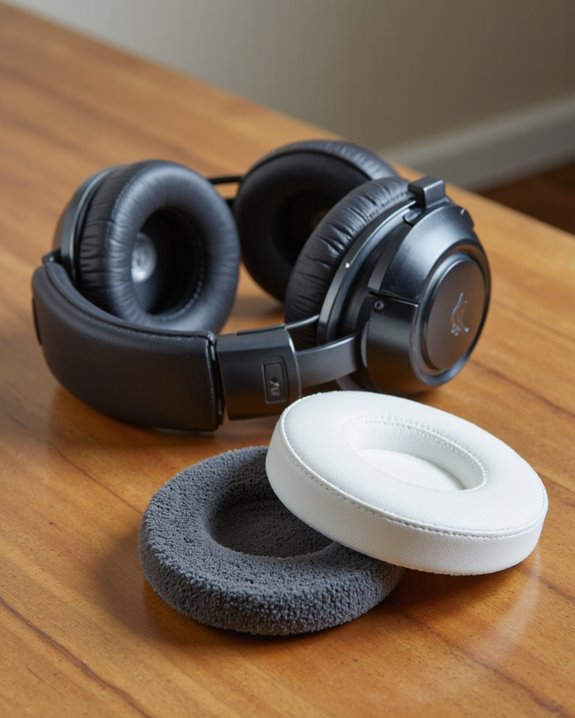
Can Headphone Cushions Be Replaced?
Absolutely, we can replace headphone cushions, restoring both comfort and ideal sound quality. Most headphone models feature ear pads that attach via tabs, clips, or adhesive rings, making removal and installation straightforward—often taking just minutes. Regular replacement, ideally every six months or after 350 hours of use, maintains noise isolation, prevents material breakdown, and upholds the intended acoustic performance. Selecting compatible cushions with proper sealing is essential; next, we’ll show how simple upgrades enhance durability and your listening experience.
Key Takeaways
- Yes, headphone cushions can be replaced when they show signs of wear like flaking, tearing, or discomfort.
- Replacement cushions are available for most popular headphone models and can restore comfort and sound quality.
- Removing old ear pads is typically a simple process involving gently pulling them off and avoiding damage to internal components.
- Installing new cushions involves aligning and pressing them onto the earcups, ensuring a proper seal for optimal performance.
- Choosing compatible, high-quality replacement pads is important to maintain the intended acoustic properties and comfort of your headphones.
Signs Your Headphone Cushions Need Replacement
Although headphone cushions might seem like a minor part of our audio equipment, recognizing when they need replacement is essential for maintaining both comfort and sound fidelity. Over time, we’ll notice signs such as flaking, tearing, or flattening on the cushions to your headset—these physical changes indicate material degradation, which can compromise the acoustic seal. Industry guidelines suggest replacing them every six months or after 350 hours of use. If we have facial hair, friction may cause accelerated wear, requiring more frequent Replacement Ear cushions. In addition, exposure to extreme temperatures or improper storage can hasten this process. Discomfort or diminished sound quality also signals it’s time to upgrade the ear cushions, ensuring the headset maintains ideal performance and user comfort.
Benefits of Replacing Worn-Out Ear Pads
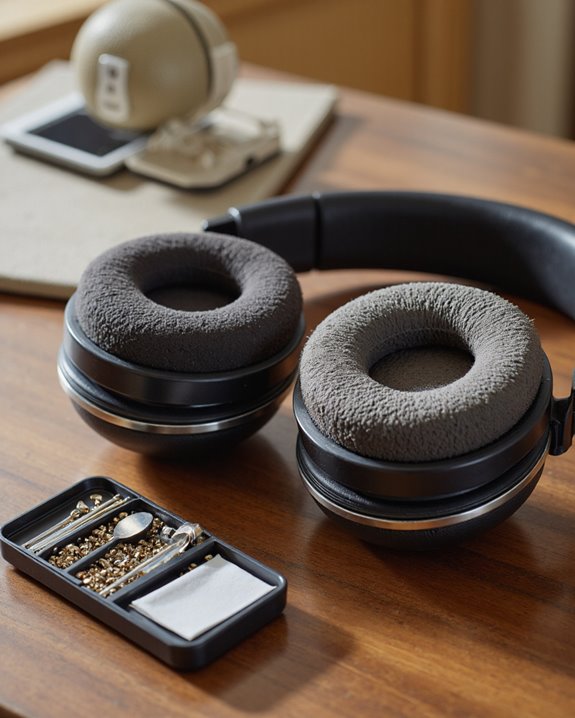
Once we’ve identified the signs that our headphone cushions are worn out, it’s important to understand the substantial benefits of timely replacement. Replacing ear pads restores the best acoustic seal, which directly impacts sound quality and noise isolation—essential for both casual listening and critical audio work. Fresh ear cushions also enhance comfort, allowing us to wear headphones for extended periods without irritation. Over time, degraded materials can affect both the durability and performance of our headphones; regular ear pad replacement—ideally every six months or 350 hours of use—helps maintain peak function and extend device lifespan. New ear pads reinstate the manufacturer’s intended acoustic characteristics, ensuring we experience audio as designed. In short, proactive maintenance safeguards both comfort and performance. Additionally, compatibility with features like noise reduction ratings ensures that hearing protection headphones continue to provide effective attenuation as intended.
How to Remove Old Headphone Cushions

Start by positioning the headphones on a flat, stable surface, which provides better control during the removal process. To begin removing the ear cushions, firmly grasp one side of the cushion and pull outward and upward with steady pressure. Be careful not to disturb any material that covers the speaker inside the earcup, as this layer is essential for audio performance. Some headphones feature small tabs or clips along the inside rim—gently disengage these if present to avoid damaging the housing. Once the cushion is fully detached, inspect the earcup for leftover debris or residue, which could interfere when you attach a new set. Verify the earcup is clean and undamaged before proceeding, as cleanliness directly affects the fit and longevity of replacement cushions.
Step-by-Step Guide to Installing New Ear Pads
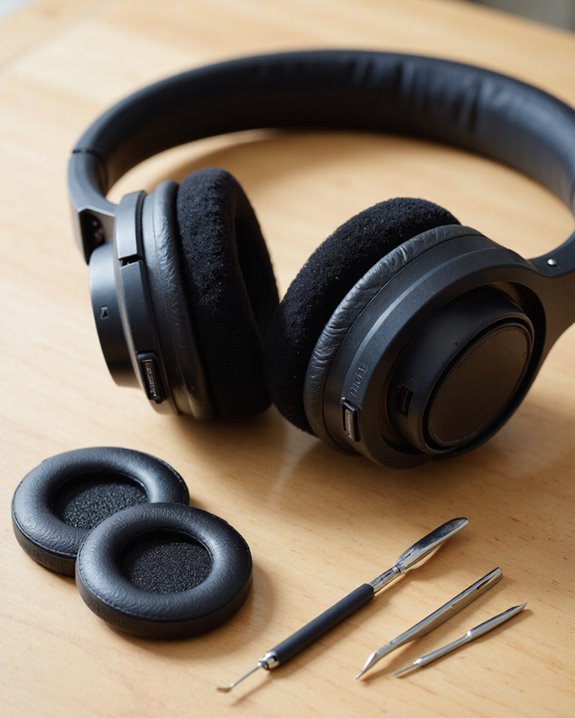
With the old cushions removed and the earcup surface clean, we’re ready to install the new ear pads. Begin by identifying the small tabs along the inside rim of each earcup—these are essential for securing the new ear cushions. Align the mounting flange on the back of your replacement pads with the rim, ensuring the orientation matches the original setup. Gently press around the edges, working your way evenly to snap the cushion into place. Take care to avoid leaving any gaps, as proper alignment maintains the acoustic seal and optimizes comfort. Once installed, run your fingers around the perimeter of the cushion, checking that it’s fully seated. This methodical approach to installing new ear pads helps preserve sound quality and extends headphone longevity.
Choosing the Right Replacement Cushions
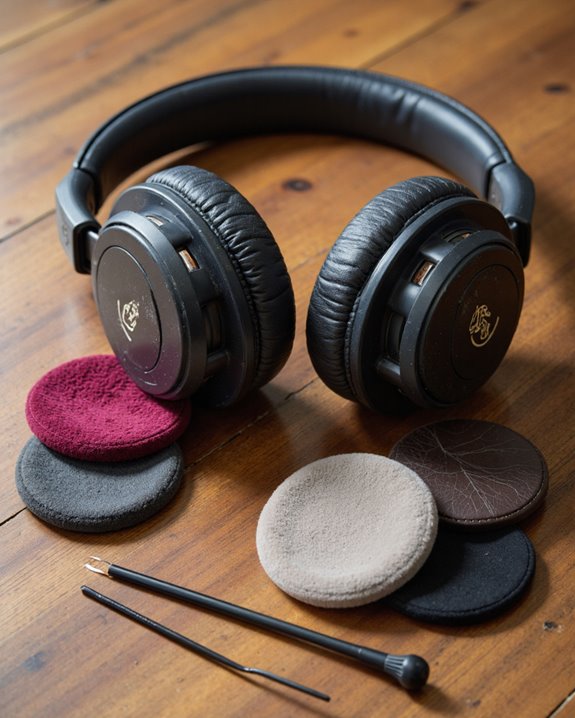
How do we guarantee our headphones deliver both comfort and ideal audio performance when it’s time to replace the cushions? The key lies in selecting the right replacement cushions. First, we must confirm compatibility—cushions designed for Beats Studio 2 may not fit the Beats Studio 3, so it’s essential to match our model precisely. Material selection is equally important: leather offers durability and good isolation, velvet provides breathability, and memory foam enhances comfort but may affect the seal. For best noise cancellation, we should prioritize cushions that form a tight, consistent seal. Analyzing user reviews and community feedback helps us gauge long-term performance and comfort. By weighing these factors, we make an informed choice, ensuring our Beats Studio headphones maintain both comfort and sound integrity. Considering that many top headphones use memory foam padding for even pressure distribution and enhanced comfort can guide our selection for replacement cushions.
The Impact of Cushion Material on Sound Quality

Although often overlooked, the material composition of headphone cushions plays a pivotal role in shaping the overall sound signature and listening experience. Different ear cushions—such as foam, leather, and velour—each influence sound quality in distinct ways. For instance, high-density foam can enhance bass response due to increased damping, while leather tends to improve sound isolation, minimizing outside noise and leakage. Velour, on the other hand, may offer a more open, airy sound but with less isolation. The thickness and shape, especially with angled pads, can change how audio frequencies reach our ears, subtly altering frequency response—sometimes by as much as 1 dB. These material-driven changes are especially noticeable to discerning listeners seeking precise sound signatures.
Tips for Maintaining and Extending Cushion Life
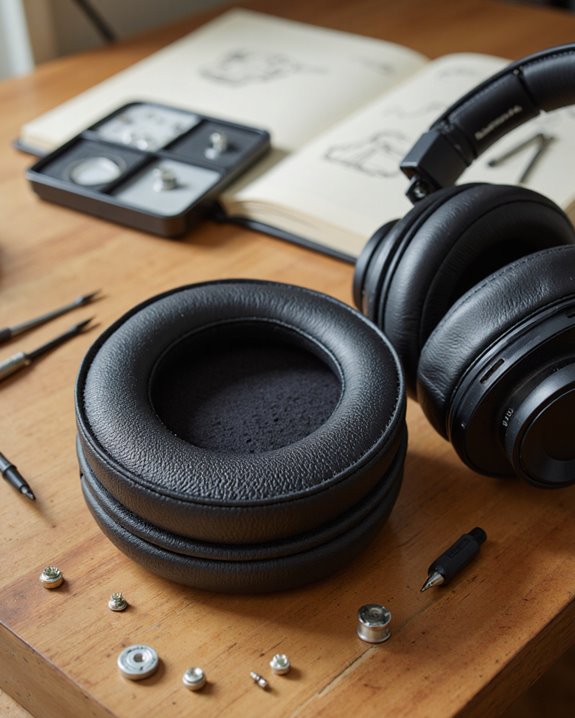
Maintaining the integrity of our headphone cushions isn’t just about aesthetics—it’s fundamental to preserving both sound quality and user comfort over time. We should start by cleaning the set of ear cushions regularly with a dry, lint-free cloth. This simple step helps remove dust and oils, which can degrade cushion materials. Storing headphones in a cool, dry environment also prevents damage from humidity and temperature extremes, both of which accelerate material breakdown. Periodically, let’s inspect for signs of wear—flaking, flattening, or tearing indicate it’s time for replacing the ear cushions to maintain peak performance. Avoid exposing cushions to sharp objects or compressive force during storage. Finally, adhering to the manufacturer’s recommended replacement intervals—typically every six months or 350 hours of use—ensures consistent comfort and sound fidelity.
Popular Replacement Ear Pad Options for Top Brands
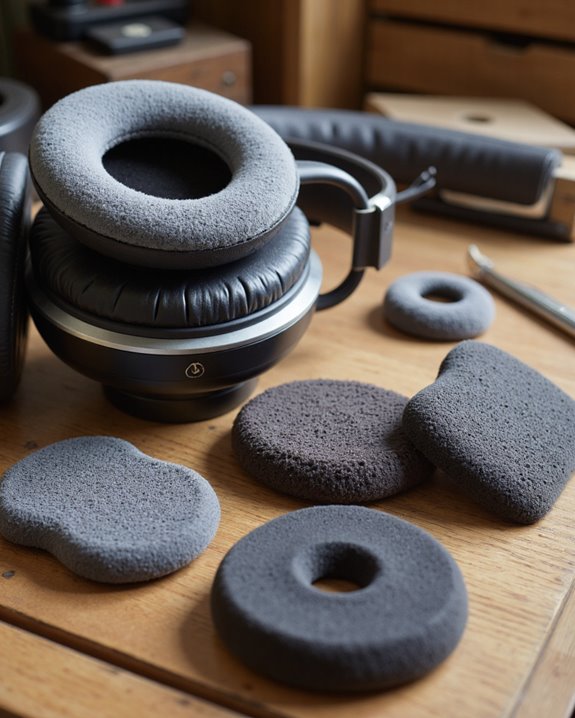
Anyone seeking to refresh their headphones without a full upgrade will find a range of high-quality replacement ear pads available for today’s top brands.
Bose offers the QC35 Replacement Ear Pads at $17.95, engineered for a precise fit and maintaining acoustic integrity. Beats Studio Earpads, priced at $19.95, feature memory foam and protein leather for improved comfort and durability. If we’re using a gaming headset, Corsair Virtuoso Earpads—at $29.95—provide plush padding suited for extended sessions. For audio professionals, Sennheiser HD 280 and Sony WH CH500 replacement pads guarantee compatibility, ensuring consistent sound quality. Most replacement ear pads now come in multiple colors and materials, enabling us to personalize our headsets without compromising performance or fit, and supporting ongoing use of our preferred models.
Frequently Asked Questions
Is It Possible to Replace Headphone Cushions?
Haven’t we all wished for a comfier listening experience? We can absolutely swap out old pads with DIY cushion replacement. With replacement compatibility in mind, let’s easily refresh our headphones, ensuring comfort and sound quality are always exceptional.
Can You Buy Replacement Ear Pads for Headphones?
We understand you’re wondering if you can buy replacement ear pads for headphones. Absolutely—there are plenty of replacement options available, with a variety of cushion materials, styles, and colors to help us personalize and refresh our headphones.
What to Do When Headphone Cushion Falls Off?
Like knights tending armor, we should approach headphone maintenance with care. If a cushion falls off, let’s inspect, realign, and secure it. Cushion care guarantees comfort and sound quality—replace it if a snug fit isn’t possible.
Can You Buy Replacement Headphone Pads?
We can definitely buy replacement headphone pads, choosing from a range of replacement materials and styles. It’s important to check cushion compatibility with our headphone model, ensuring a perfect fit and restoring comfort and performance easily.


